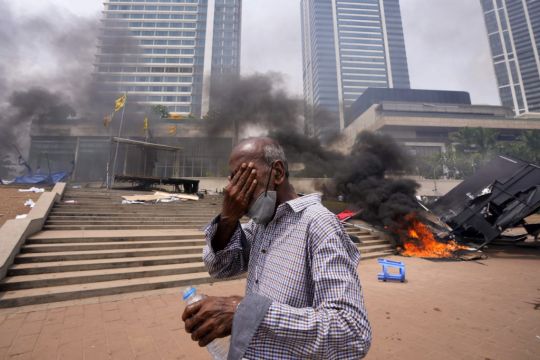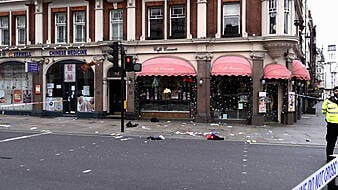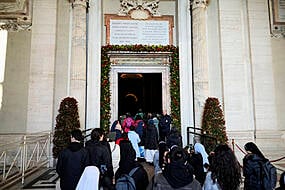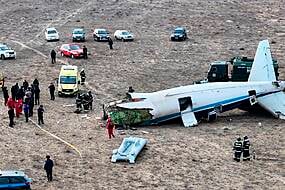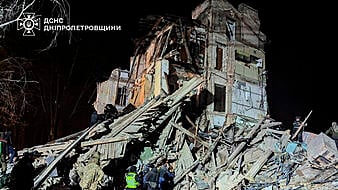Sri Lankan prime minister Mahinda Rajapaksa has resigned after weeks of protests demanding he and his President brother quit, an official said.
It comes after troops were deployed to the capital after government supporters attacked protestors camped outside the President and prime minister’s offices.
Trade unions on Monday began a “week of protests” demanding the government change and its President Gotabaya Rajapaksa step down over the country’s worst economic crisis in memory.
An aid to the prime minister confirmed he has submitted a letter of resignation to the President, who is his younger sibling.
It means the entire Cabinet is dissolved, paving the way for a new government.
The Indian Ocean island nation is on the brink of bankruptcy and has suspended payments on its foreign loans.
Its financial woes brought on a political crisis, with the government facing widespread protests and a no-confidence motion in Parliament.
Buses that brought in pro-government supporters to Colombo being attacked as they leave the city. pic.twitter.com/XRXyfjy29v #LKA #SriLankaCrisis #SriLanka via @AmanthaP
— Sri Lanka Tweet 🇱🇰 💉 (@SriLankaTweet) May 9, 2022
Advertisement
Supporters of the prime minister rallied inside his office earlier on Monday, urging him to ignore the protesters’ demands to step down and requesting he remain in office.
After the meeting, they went to the front of the office, where protesters have been demonstrating for several days.
Local television channel Sirasa showed pro-government supporters attacking protesters with clubs and iron bars and demolishing and later burning down their tents.
Protesters made accusations on Sirasa TV that police did not intervene to prevent the attack, despite using tear gas and water cannons on protesters as recently as Friday.
At the main hospital in the capital Colombo, 23 wounded people were admitted, though their condition was not critical, an official said on condition of anonymity as she is not authorised to speak to the media.
The attacks came as protesters marked their 31st day outside the President’s and prime minister’s offices.
They were demanding that the President, the prime minister, and other powerful Rajapaksa family members quit.
Similar protests spread to other locations, with people setting up camps opposite the prime minister’s residence and in other towns across the country.

Until Monday, the Rajapaksa brothers had resisted calls to resign, though three Rajapaksas out of the five who were politicians stepped down from their Cabinet posts in April.
Trade unions have called for protests throughout this week, trade union activist Saman Rathnapriya said, and more than 1,000 unions representing health, port, education, and other key service sectors have joined the “week of protests” movement.
He said that, during the week, the workers will stage demonstrations at their workplaces across the country.
At the end of the week, they will launch a huge march up to Parliament, demanding the President’s removal and a new government.
For several months, Sri Lankans have endured long queues to buy fuel, cooking gas, food and medicine, most of which come from abroad.
Shortages of hard currency have also hindered imports of raw materials for manufacturing and worsened inflation, which surged to 18.7% in March.
People blocked main roads to demand gas and fuel.
On Sunday, local television channel Hiru showed people in some areas fighting over fuel.

Sri Lanka was due to pay £5.7 billion of its foreign debt this year out of nearly £20.3 billion it must pay by 2026.
Its total foreign debt is £41.5 billion.
Sri Lanka’s finance minister announced earlier this week that the country’s usable foreign reserves have plummeted below £40.7 million.
As oil prices soar during the Russia-Ukraine conflict, Sri Lanka’s fuel stocks are running out.
Authorities have announced country-wide power cuts will increase to about four a day because they cannot supply enough fuel to power stations.
Protesters have crowded the streets since March, maintaining that Mr Rajapaksa and his family — who have dominated nearly every aspect of life in Sri Lanka for most of the last 20 years — are responsible for the crisis.
On Friday, Mr Rajapaksa declared a state of emergency, which empowers him to authorise detentions, property seizure and search of any premises.
He can also change or suspend any law in the interests of public security and for the maintenance of essential supplies.
Diplomats and rights groups have expressed concern over the move.
Sri Lanka has been holding talks with the International Monetary Fund to get an immediate funding facility as well as a long-term rescue plan but was told its progress would depend on negotiations on debt restructuring with creditors.
Any long-term plan would take at least six months to get underway.
